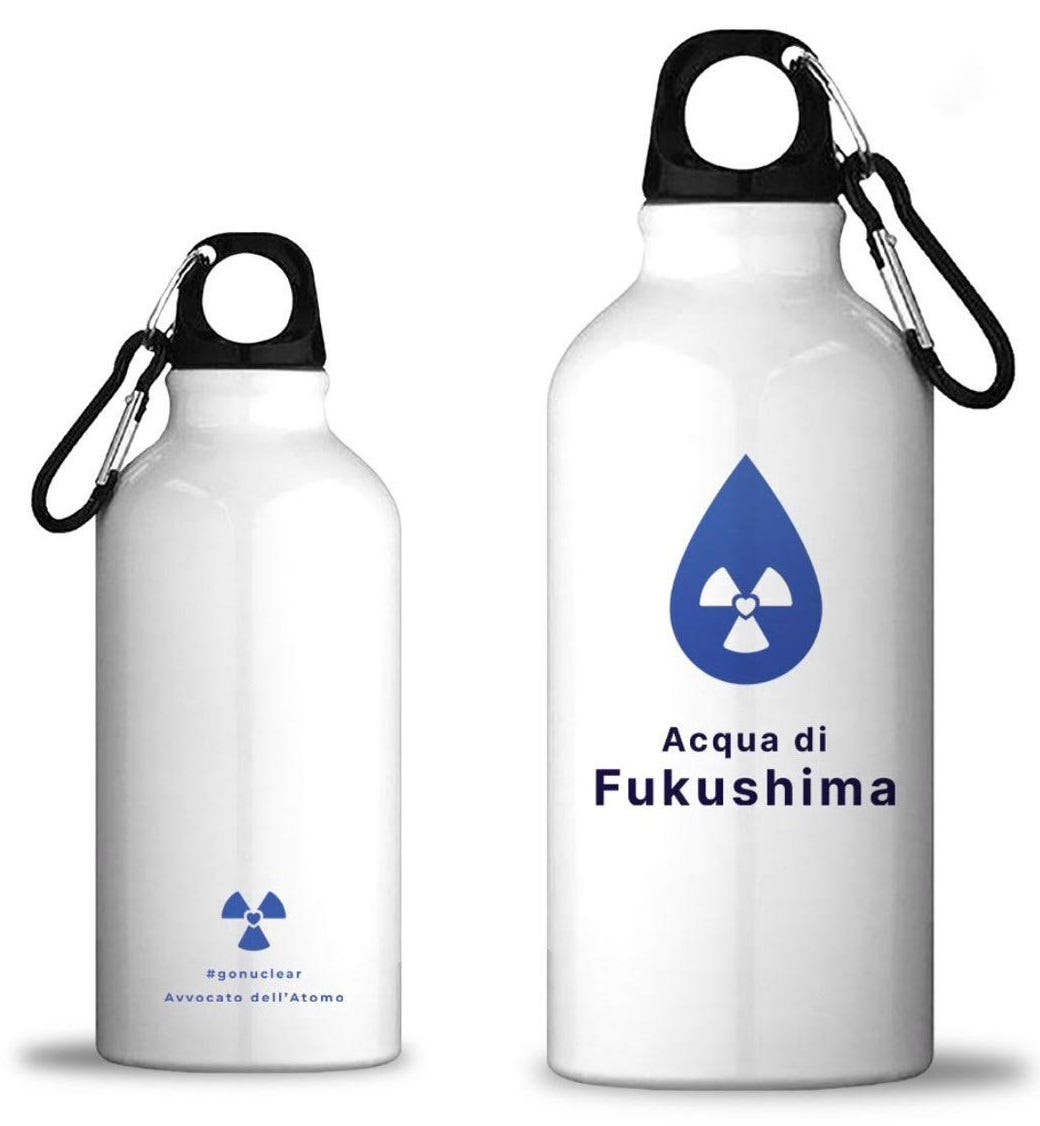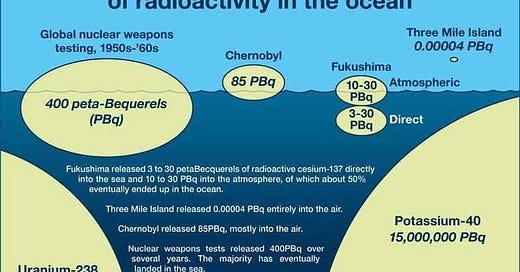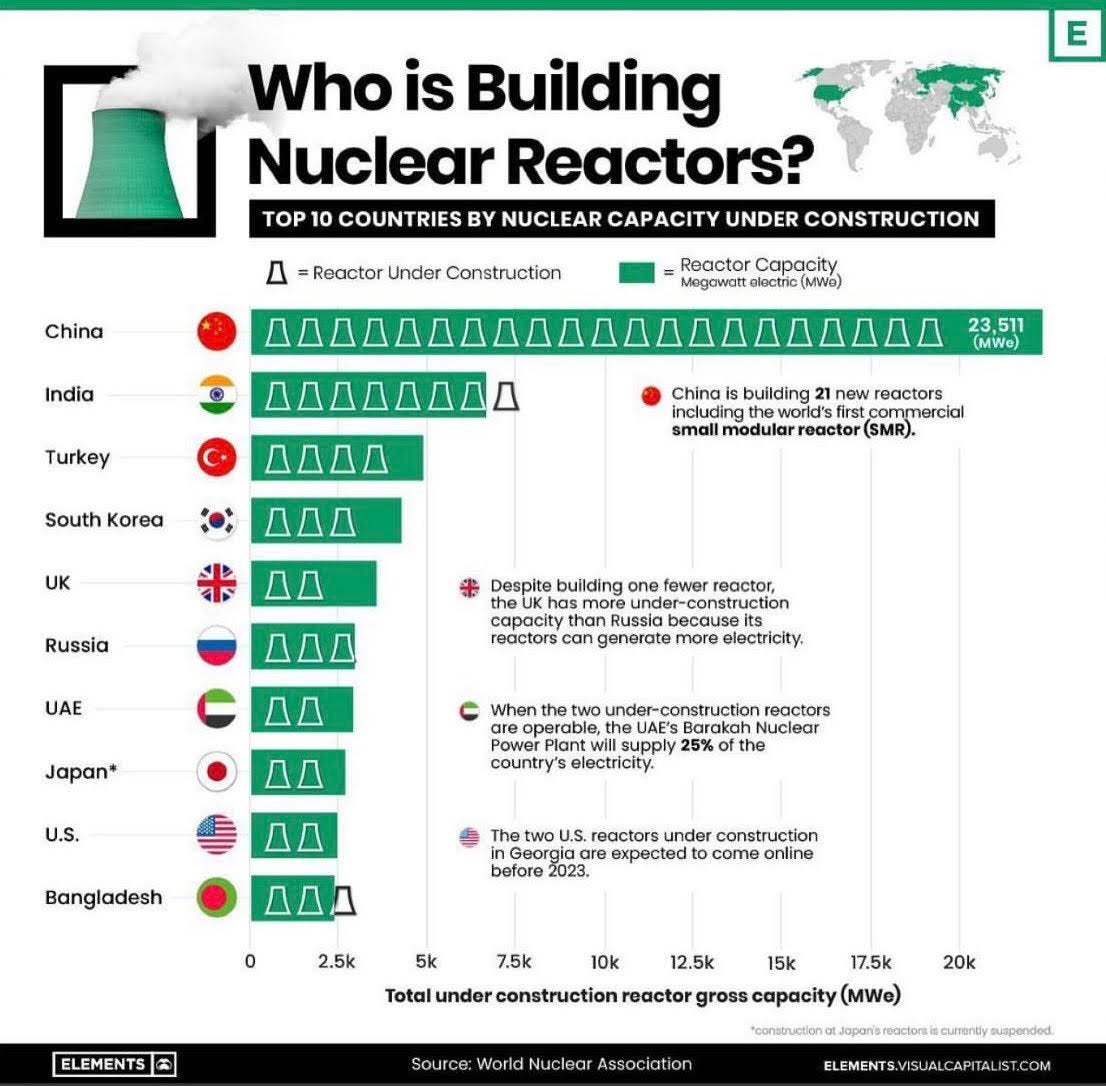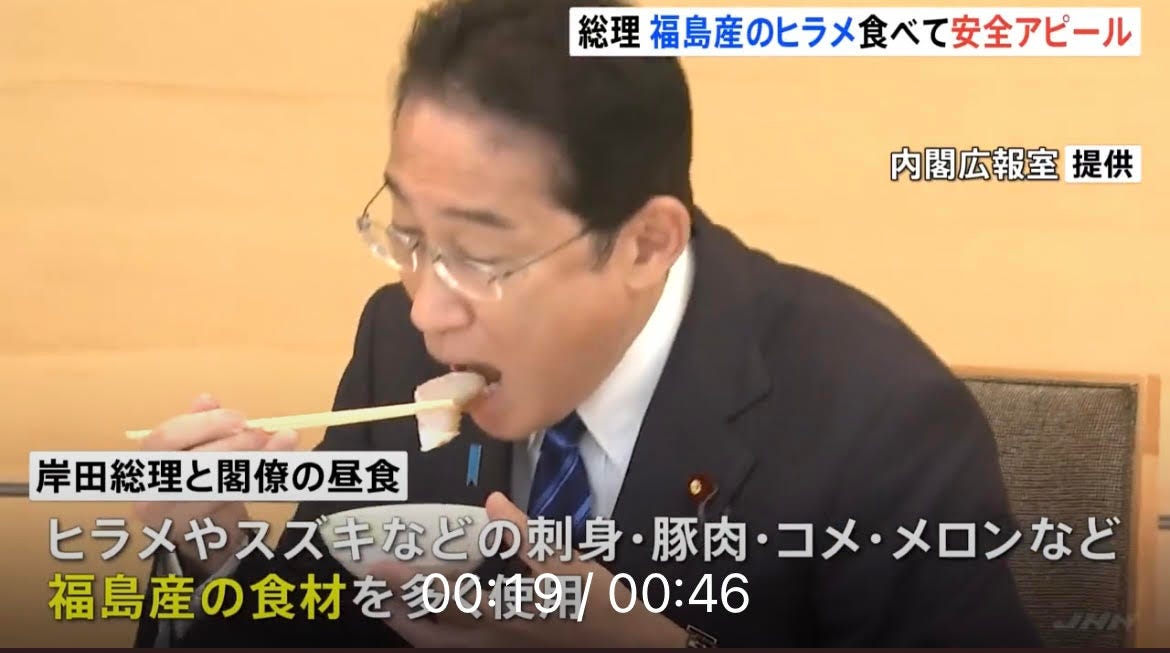There’s TRITIUM in the water! What are we going to do??!
First of all, stop panicking.
What’s going on?
Treated water from the Fukushima Daiichi nuclear power plant is being released into the sea, and some people are panicking – especially in China. China has banned seafood products from Japan, Chinese people have been calling for boycotts of Japanese products, Japan's GDP could shrink by around $8.2 billion (0.2%) if inbound tourism from China does not recover, South Korean police had to arrest 16 protesters who targeted the Japanese embassy, and a wave of online harassment directed at Japanese people got so bad that it prompted Tokyo to summon the Chinese ambassador regarding what the media has named ‘a spam monster’.
In 2011 the Tōhoku earthquake and tsunami devastated Japan and claimed around 20,000 lives. They also triggered a meltdown at the Fukushima Daiichi nuclear power plant, which didn’t claim lives but led to an evacuation of the area and considerable panic around the world.
At the time, and ever since, contaminated water was stored on the power plant site and now, 12 years later, that water has been filtered and is ready to be released into the sea. The Tokyo Electric Power Company (TEPCO) developed a filtration system to remove most of the radioactive contamination from the water, which is known as the Advanced Liquid Processing System (ALPS), but the water still contains a radioactive element of hydrogen called tritium, which can't be removed. The way tritium is usually dealt with is by diluting the water to make its presence insignificant.
Tritium is a naturally occurring radio-isotope, which is used in wristwatch faces, rifle sights and exit signs. The tritium level in the so-called ‘Fukushima wastewater’ is lower than the amount of tritium that is present in ordinary drinking water. Since tritium is difficult to separate from water, dilution to render it completely harmless makes sense. As is true of most elements, the impact depends on the dose. With tritium being diluted to such levels, there will be no impact on human or animal health, or the environment.
The water release began on 24 August, after extensive research into the safety aspects, which was conducted over many years. The broad consensus is that the water should be released rather than indefinitely stored on land. As environmental science professor Jim Smith has pointed out, “At any other nuclear site in the world, this would be considered a ‘routine’ release of treated wastewater with very low levels of radioactivity.”

The United Nations atomic energy regulator, the International Atomic Energy Agency (IAEA) has found the discharge of filtered water into the Pacific Ocean to be safe, and in a comprehensive report on the water release it states that: “The approach and activities to the discharge of ALPS treated water taken by Japan are consistent with relevant international safety standards. Furthermore, the IAEA notes the controlled, gradual discharges of the treated water to the sea, as currently planned and assessed by TEPCO, would have a negligible radiological impact on people and the environment.”
The water will be discharged at a maximum rate of 132,000 gallons per day through an underwater tunnel off the coast of Japan. The first release is one of four, scheduled between now and the end of March 2024. The IAEA will monitor the release process.
One of the measures of radiation is the Becquerel (Bq). According to Japanese authorities, the concentration of tritium will drop to background ocean levels after being diluted. That’s because tritium is already naturally present in seawater, since oceans are naturally radioactive. According to the IAEA, the tritium concentration in the water discharged is "far below the operational limit of 1,500 becquerels per litre (Bq/L)". The amount of tritium in the water release is expected to be about seven times lower than the World Health Organisation limit for tritium in drinking water, which is at 10,000 Bq/L. We are already exposed to tritium in small amounts in tap water and rain, and the exposure from the water release will be more than a thousand times less than the doses we get from natural background radiation each year.
In short, you could drink this water and not experience adverse effects from it. It is, effectively, drinking water.
So why are people panicking about this water release?
Is this really about tritium? Geopolitical power plays
China has 51 operational nuclear reactors and 21 more under construction. It has an ambitious nuclear program – with more than two and a half times more nuclear reactors under construction than any other country. As well as needing to meet a huge and growing energy demand, China understands the impacts of air pollution and is keen to transition away from coal as soon as possible to improve air quality.
In 2021, 13 nuclear power plants in China released more tritium into the ocean than the annual total Fukushima water release will. According to Chinese data, the Qinshan power plant in the Zhejiang Province released 218 trillion becquerels of tritium in 2021, which is about ten times the maximum amount of tritium to be discharged from the Fukushima Daiichi plant in a year. China’s nuclear power plants release water with much higher levels of tritium than the Fukushima water, and yet there is no global panic about the country doing so.
China and Japan have had a fractious relationship for a long time, and it is not uncommon for Chinese people to call for bans on Japanese products when the opportunity arises. The US envoy has called China’s response economic coercion, and analysts have posited that it is a deliberate attempt to undermine Japan.
It may also be the case that, just as Russia was found to have undermined European energy security, China is doing the same with Japan – stoking old fears about a tsunami to undermine faith in nuclear energy as a whole. After all, the worst impact of the closures of nuclear power plants after the earthquake was the loss of life caused by the fossil fuels that replaced clean energy. If the energy crisis fuelled by the Russian invasion of Ukraine has taught us anything, it’s that energy security is paramount. China isn’t against nuclear energy, but eroding public trust in nuclear energy globally could result in financial and political gain for the country.
As usual, activists have risen to the bait and been quick to jump on the fear-mongering bandwagon. However, the concerns being aired by protestors and a few rogue scientists are related to supposed unknown impacts of the water release, which are based on supposition, not evidence. Keen not to miss the opportunity to spread the usual misinformation about nuclear energy, Greenpeace East Asia has also been active in stirring up drama about the water release.
As is typical with mainstream news reporting about anything nuclear-related, journalists around the world have also been whipping up panic, going so far as to act as though another tsunami is about to take place. For many of them, stretching the facts into an apocalypse-film-style narrative is a honed skill, like shooting fish in a barrel. For example, this Al Jazeera ‘take’ spends the first seven minutes focusing on the devastating impact of the tsunami. It then recounts what happened with the nuclear meltdown in detail, including replaying news reports from the time and reliving the fear people experienced when it happened, without explaining that the meltdown itself did not kill people.
The podcast then goes over what the host calls the ‘shocking’ amount of water that needs releasing, gets conspiratorial by blaming the company releasing the water (TEPCO) for not being trustworthy, represents fears from protesters with direct interviews in which activists call the water ‘poison’, and even speaks to people who lived through the disaster as if the water release is a repeat of the tsunami. This highly unbalanced reporting should be taken seriously, since misinformation can have far-reaching consequences, especially for energy transition goals and energy security.
Add to that this NBC article that ran with the headline “Volunteer moms are distressed about the water being discharged from the Fukushima nuclear plant,” and I think you get the picture.
But it’s not an accurate one.
Fighting misinformation with optics
In an attempt to reassure people with visuals, Japanese Prime Minister Fumio Kishida has been filmed eating fish and seafood from the region where the water is being released, to show that it is safe to consume. As well, Japan's environment ministry has published maps showing tritium levels found in waters within a 50km radius beyond Fukushima, to show that all are below dangerous levels.
To show support for Japan, another big fish, South Korean President Yoon Suk Yeol, has adopted a similar approach by dining on seafood all week to show that it’s safe.
The US and Taiwan have also backed Japan, and the UK government has stated: “The UK wishes to underscore the routine nature of aqueous discharges of tritium. It is standard practice throughout the nuclear industry globally.”
Misinformation has consequences
I have said before that the fear of nuclear energy is more dangerous than nuclear energy itself.
The water stored in Fukushima needs to be released. The water is currently stored in more than 1,000 tanks, which are vulnerable to future disasters while they remain there, and Japan says it needs the land occupied by the tanks to build new facilities to safely decommission the plant.
Keeping the water in special tanks on land indefinitely is potentially more of a risk to people, as according to the IAEA, “the storage of large quantities on site has led to higher doses for workers on site and difficulties for TEPCO in reaching the site boundary dose target of 1 mSv per year.” The water is currently stored in more than 1,000 tanks, which are vulnerable to future disasters while they remain there, and Japan says it needs the land occupied by the tanks to build new facilities to safely decommission the plant. Although 1 mSv a year is still a minuscule amount of exposure, and the lowest level of radioactivity shown to cause detectable harm is 100 mSv, it would be better to stay within the guidelines than to risk problems occurring because of imagined risks of tritium exposure in seafood. As Associate Professor of Nuclear Chemistry Mark Foreman has explained, even people who consume a lot of seafood will only be exposed to low doses of radiation, in the range of 0.0062 to 0.032 microSv per year.
Humans can safely be exposed to tens of thousands of times more than that – or up to 1,000 microSv of radiation per year.
China is the largest single market for Japanese seafood exports, and the consequences of its overblown reaction to this water release are already being felt by Japanese fishermen, whose livelihoods are being destroyed by the ban on seafood.
While activists, journalists, political vested interests, and misinformed citizens continue to shout from the rooftops that the water release will harm people, the truth is that the continued erosion of trust in science and nuclear energy is what will actually harm people. Just ask Japanese fishermen about it. And remember that although the Tōhoku earthquake and tsunami claimed many lives, the Fukushima Daiichi nuclear power plant meltdown did not, and the response of closing nuclear power plants in the wake of the meltdown led to thousands of preventable deaths.
The fact remains that of all energy sources, nuclear waste is the most well-managed, and nuclear power plants often benefit nature and the wildlife around them, including marine life. Radiation doesn’t need to be feared, only understood. With global heating and air pollution damaging people and the planet, we have bigger fish to fry.
Now that we’ve cleared that up, how about some sushi for dinner?







It helps to put the 1 mSv/year safe limit for radioactivity in perspective.
The lowest level of radioactivity shown to cause detectable harm is 100 mSv.
This causes 1% increase in the risk of cancer.
This is based on exposure to the nuclear weapons in Japan where this dose was received at an exceptionally high dose rate (a fraction of a second).
The lowest dose shown to cause detectable harm when spread over an entire year is 500 mSv.
This is should be compared with the ‘safe’ levels set for the most dangerous component in air pollution, PM2.5 particles. At the WHO approved safe level for PM2.5 already causes a 2% increase in mortality.
So a life lost to radioactivity is valued at least 500 times more than a life lost to air pollution. They should be valued the same.
This regulatory flaw is why nuclear power did not replace fossil fuel power, and is one of the causes of climate change.
Really appreciate your work. Thanks